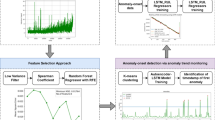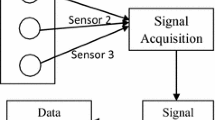Abstract
Many decomposition methods have been developed and applied to find bearing fault in recent years, but it is quite difficult to effectively extract the bearing fault characteristics, especially under strong noise and variable speed conditions. Among them, empirical mode decomposition (EMD) is the most widely used. To improve the extraction effect of rolling bearing fault features, this paper proposes a bearing fault extraction algorithm based on fractional Fourier transform (FRFT). The collected vibration signal is first analysed by envelope demodulation and mean normalisation. Secondly, the EMD method is used to remove many noise interferences and retain the bearing fault characteristics. Finally, an effective FRFT filtering algorithm is applied to find fault characteristic signal and remove the residual noise. Both simulated and experimental analyses are conducted to illustrate the performance of the proposed method. The results indicate that this method can accurately and completely extract the unknown bearing fault features from raw signal, which contains noise and irrelevant vibration signals. The proposed algorithm may provide reference for the fault diagnosis of other machine elements, such as gears.
















Similar content being viewed by others
References
R B Randall and J Antoni, Mech. Syst. Signal Process. 25, 485 (2011)
I El-Thalji and E Jantunen, Mech. Syst. Signal Process. 60, 252 (2015)
Z Feng, X Chen and T Wang, J. Sound Vib. 400, 71 (2017)
M Zhao, J Lin, X Xu and Y Lei, Sensors 13, 10856 (2013)
P Borghesani and R Ricci, Mech. Syst. Signal Process. 38, 23 (2013)
T Wang, M Liang, J Li and W Cheng, Mech. Syst. Signal Process. 45, 139 (2014)
C Mishra, A K Samantaray and G Chakraborty, Mech. Syst. Signal Process. 72, 206 (2016)
N E Huang et al, Proc. R. Soc. A 459, 2317 (2003)
Y Lei, J Lin, Z He and M J Zuo, Mech. Syst. Signal Process. 35, 108 (2013)
S Mohanty, K K Gupta and K S Raju, IET Sci. Meas. Technol. 11, 30 (2017)
Y Xu, Z Cai and K Ding, Sci. Technol. 29, 095108 (2018)
Y Sun, S Li and X Wang, Measurement 176, 109100 (2021)
C Yin et al, Mech. Syst. Signal Process. 171, 108834 (2022)
J Shi, M Liang, D S Necsulescu and Y Guan, J. Sound Vib. 368, 202 (2016)
C Li, V Sanchez, G Zurita, M Cerrada Lozada and D Cabrera, ISA Trans. 60, 274 (2016)
J Mei, J Jia, R Zeng, B Zhou and H Zhao, Measurement 91, 532 (2016)
L B Almeida, IEEE Trans. Signal Process. 42, 3084 (1994)
H M Ozaktas and O Ankan, IEEE Trans. Signal Process. 44, 2141 (1996)
H Xu and F Liu, IEEE Int. Conf. Inf. Autom. ICIA 408 (2010)
S A Elgamel and J J Soraghan, IEEE Signal Process. Lett. 18, 263 (2011)
H Hao, Optik 124, 6093 (2013)
X Li, Z Ma, D Kang and X Li, Meas. J. Int. Meas. Conf. 155, 107554 (2020)
G Tang, Y Huang and Y Wang, Measurement 171, 108777 (2021)
J Yang, C Wu, Z Shan, H Liu and C Yang, Meas. Sci. Technol. 32, 105021 (2021)
G Chen et al, Meas. Sci. Technol. 32, 115024 (2021)
Z Feng, X Chen and T Wang, J. Sound Vib. 400, 71 (2017)
K Dragomiretskiy and D Zosso, IEEE Trans. Signal Process. 62, 531 (2013)
S Chen et al, IEEE Trans. Signal Process. 65, 6024 (2017)
Z Meng et al, Meas. Sci. Technol. 33, 125107 (2022)
S Chen et al, J. Sound Vib. 440, 83 (2019)
Author information
Authors and Affiliations
Corresponding author
Rights and permissions
About this article
Cite this article
Yu, Z., Jiang, B., Zhu, J. et al. An improved decomposition method for extracting unknown rolling bearing fault features from strong noise. Pramana - J Phys 97, 71 (2023). https://doi.org/10.1007/s12043-023-02542-z
Received:
Revised:
Accepted:
Published:
DOI: https://doi.org/10.1007/s12043-023-02542-z
Keywords
- Fault feature extraction
- empirical mode decomposition
- fractional Fourier transform
- variable speed condition




